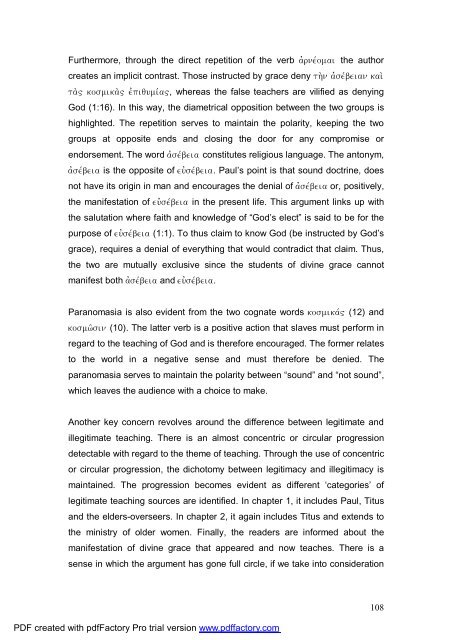A Text centred rhetorical analysis of Paul's Letter to Titus
A Text centred rhetorical analysis of Paul's Letter to Titus
A Text centred rhetorical analysis of Paul's Letter to Titus
Create successful ePaper yourself
Turn your PDF publications into a flip-book with our unique Google optimized e-Paper software.
Furthermore, through the direct repetition <strong>of</strong> the verb ajrnevomai the author<br />
creates an implicit contrast. Those instructed by grace deny th;n ajsevbeian kai;<br />
ta;" kosmika;" ejpiqumiva", whereas the false teachers are vilified as denying<br />
God (1:16). In this way, the diametrical opposition between the two groups is<br />
highlighted. The repetition serves <strong>to</strong> maintain the polarity, keeping the two<br />
groups at opposite ends and closing the door for any compromise or<br />
endorsement. The word ajsevbeia constitutes religious language. The an<strong>to</strong>nym,<br />
ajsevbeia is the opposite <strong>of</strong> eujsevbeia. Paul’s point is that sound doctrine, does<br />
not have its origin in man and encourages the denial <strong>of</strong> ajsevbeia or, positively,<br />
the manifestation <strong>of</strong> eujsevbeia in the present life. This argument links up with<br />
the salutation where faith and knowledge <strong>of</strong> “God’s elect” is said <strong>to</strong> be for the<br />
purpose <strong>of</strong> eujsevbeia (1:1). To thus claim <strong>to</strong> know God (be instructed by God’s<br />
grace), requires a denial <strong>of</strong> everything that would contradict that claim. Thus,<br />
the two are mutually exclusive since the students <strong>of</strong> divine grace cannot<br />
manifest both ajsevbeia and eujsevbeia.<br />
Paranomasia is also evident from the two cognate words kosmikav" (12) and<br />
kosmw`sin (10). The latter verb is a positive action that slaves must perform in<br />
regard <strong>to</strong> the teaching <strong>of</strong> God and is therefore encouraged. The former relates<br />
<strong>to</strong> the world in a negative sense and must therefore be denied. The<br />
paranomasia serves <strong>to</strong> maintain the polarity between “sound” and “not sound”,<br />
which leaves the audience with a choice <strong>to</strong> make.<br />
Another key concern revolves around the difference between legitimate and<br />
illegitimate teaching. There is an almost concentric or circular progression<br />
detectable with regard <strong>to</strong> the theme <strong>of</strong> teaching. Through the use <strong>of</strong> concentric<br />
or circular progression, the dicho<strong>to</strong>my between legitimacy and illegitimacy is<br />
maintained. The progression becomes evident as different ‘categories’ <strong>of</strong><br />
legitimate teaching sources are identified. In chapter 1, it includes Paul, <strong>Titus</strong><br />
and the elders-overseers. In chapter 2, it again includes <strong>Titus</strong> and extends <strong>to</strong><br />
the ministry <strong>of</strong> older women. Finally, the readers are informed about the<br />
manifestation <strong>of</strong> divine grace that appeared and now teaches. There is a<br />
sense in which the argument has gone full circle, if we take in<strong>to</strong> consideration<br />
PDF created with pdfFac<strong>to</strong>ry Pro trial version www.pdffac<strong>to</strong>ry.com<br />
108

















